Not very long ago, the Ghana Statistical Service released the new inflation figures for the month of April 2019. According to the data released by the GSS, the inflation rate for the month of April rose to 9.5 percent from a rate of 9.3 percent recorded in March the same year. This increase to 9.5 percent represents a 0.2 percentage points increase over that of the previous month.
For the benefit of proper understanding for persons who are not technically positioned to understand most of these economic terms, let’s take a moment to explain what inflation and Consumer Price Index mean.
Inflation, in this context, refers to an increase in the general level of prices of goods and services or an increase in the cost of living over a period of time. So generally, inflation is about the rate at which the prices of goods and services increase over time.
How do we arrive at the rate of inflation?
Inflation rate is calculated by the use of the Consumer Price Index (CPI). People often misconstrue the difference between inflation rate and consumer price index. The CPI is just an index used to calculate inflation rate. CPI measures the change over time in the general level of prices of goods and services that households acquire for the purpose of consumption with reference to a base year. In simple terms, CPI measures the average change over time in the prices paid by consumers for a basket of goods and services. On the other hand, inflation is the general upward price movement of goods and services in the economy. On the whole, CPI is a factor in determining inflation.
Why inflation rate is an issue as far as standard of living is concerned
Inflation is the major factor that determines the standard of living of people. Standard of living refers to the degree of wealth and material comfort available to a person or a group of people in a defined locality. In essence, standard of living is about how a person or in general, persons within a specific geographic setting afford the necessities of life and how comfortably they live.
Standard of living is largely based on two factors;
1. Income
2. Expenses
3. Inflation occurs when day to day expenses rise.
Many at times, inflation is slow that it goes unnoticed. However, there are instances where the increase in prices are so dramatic that it becomes significant for consumers to notice a persistent increase in the prices they pay for the same goods. The ripple effect of this is that, consumers start to experience high cost of living. That is, with a constant income, they begin to pay more for the same basket of goods and services. This comes as a result of a decrease in their purchasing power. To put it succinctly, a product that a consumer purchased for GHS 10 before a rise in inflation will cost higher, say GHS 15, depending on the rate of inflation. So in general, with high levels of inflation, the basket of goods and services that a consumer used to purchase at a certain price is reduced with the same income. This implies that with the same amount of income in the face of high levels of inflation, consumers can’t keep up with their levels of consumption.
To maintain their previous levels consumption in the face of high inflation rate, there must be a corresponding increase in income of consumers as the rate of increase in the inflation.
For instance, if inflation increases by 10 basis points, there should be a corresponding 10 basis point increase in incomes of consumers before they can maintain the same level of consumption. Since this is almost impossible, consumers’ purchasing power is reduced due to the high cost of living thereby leading to a fall in the standard of living. The most affected in this event of high levels of inflation is the poor.
A synopsis of Ghana’s inflation rate for April
Now that it is established that everybody is affected by inflation with the poor being the most affected, let’s focus on the components of inflation and what really caused the increase in the rate for April. The consumer basket over which the CPI is calculated has various goods and services that can be categorized into two; Food and Non-food. The inflation rate for food is calculated differently so as the non-food.
Components of the food inflation.
The components of the food inflation comprise of the following major subgroups
1. Coffee, cocoa and tea
2. Fruits
3. Mineral water, soft drinks
4. Meat and meat products
5. Vegetables
6. Fish and sea food
7. Sugar, jam, honey and chocolate
8. Oils and fats
9. Food products n.e.c
10. Milk, cheese and eggs
11. Cereals and cereal products.
In general, the inflation rate for the food inflation in the month of April was 7.3 percent compared to 8.4 percent in the previous month. That is, there was 1.1 percent deflation. This implies that, the rate at which food prices increased in the month of March slowed by 1.1 percent. This is very positive for the economy as food, which is a basic necessity of life had it’s prices remaining stable.
Lets now focus on the other component of the national inflation which is the non-food inflation. This will be the focus of the subsequent discussions. Let’s not forget that the first component of the national inflation which is Food Inflation for the month of April recorded 1.1 percent decrease. That is, from 8.4 percent in March to 7.3percent in April.
Non-food inflation.
For the non-food inflation aspect of the national inflation, the components are grouped into the following groupings:
1. Clothing and footwear
2. Recreation and culture
3. Transport
4. Furnishings and Household Equipment
5. Miscellaneous good and services
6. Alcoholic Beverages and tobacco
7. Hotels, Cafes and Restaurants
8. Education
9. Communication
10. Housing, Water, Electricity, gas etc
11. Health
In general the inflation rate of Non-food inflation which comprise of the above groupings recorded a rate of 10.4 percent in April 2019 compared to 9.7 percent in March 2019. This implies that, there was an increase of 0.7 percent in the month of April 2019.
From the above analysis, it can be deduced that what really caused the increase in the national inflation was the Non-food Inflation component. That is, the 0.7 percent increase in the non-food inflation reflected in a 0.2 percent increase in the national inflation. Thanks to the decrease in the food inflation component’s rate, else the increase would have been much worse than what was recorded.
Let’s now focus on the driving forces that really caused the upsurge in the non-food inflation rate which also then rippled in the increase of the national inflation.
First of all, it has been established that the inflation rate for the non-food component was 10.4 percent which also doubles as the average of the group. The inflation rate for the non-food component is derived from averaging the inflation rate for all the various groups within the non-food inflation components. Four of the groups within the non-inflation component were the main driving forces the caused the increase in the rate of inflation for the non-food component. These groups recorded group inflation rate greater than the rate of the entire non-food inflation rate of 10.4 percent.
The table below shows these groups and their inflation rate;

In effect, the above groupings are main the main drivers that caused the increase in the national inflation for the month of April 2019. A critical analyses of these groups depicts that these goods and services are mostly imported things and things that are highly volatile to price change in any instance of exchange rate imbalances. For instance, the “clothing and footwear group” and “Furnishing, household equipment and routine maintenance group’ are goods that are mostly imported from outside economies. Transport cost is mostly associated with crude oil price increase on the international market and exchange rate instability.
With this high importation of these goods and services coupled with the cedi depreciation in the first quarter of 2019, has resulted in this monthly increase in inflation since January 2019. As it is widely known, an economy which is heavily dependent on importation cannot be spared in any case of exchange rate imbalances. Since the cedi depreciated within the first quarter of 2019, which implied that importers needed more cedi currency for the same unit of dollars in order to import, importers being rational economic agents will increase their prices to make up for the extra cedi lost as result of the depreciation. Hence, consumers had to pay the price through the increase in prices of this imported goods and services.
What made the situation worse was the persistent nature of the cedi depreciation challenge experienced this year. This resulted in a repetitive cycle of price increase whenever the cedi depreciates. As it was been explained earlier, whenever an increase in prices become persistent indicates inflation. Therefore, the high import driven economy augmented by the cedi depreciation encountered this year are the main reasons for the slight upsurge in Ghana’s inflation rate. It can be said that, this is as a result of our consumption pattern of heavily depending on imported commodities. This is because from the data above the drivers of April 2019 inflation rate are good and services mostly imported.
What to do
High levels of inflation is very destructive of standard of living especially with the poor being the most affected. It therefore very reasonable to keep inflation at very moderate levels that will ensure good standard of living for all. Although the inflation rate of 9.5 percent currently is within the target of 8 + or – 2 percent set for the 2019 fiscal year, if care is not taken the target will be missed.
It is therefore needful for a change in our consumption pattern. The high taste of foreign goods have proven to destabilize our exchange rate which in turn results in inflation. We all must therefore patronize the substitute of these goods produced locally in order to an economy devoid of exchange rate instability and high inflation.
That is, the attitude of having strong taste for foreign goods at the expense of locally made goods needs to be eschewed. We must strongly desist from that character of patronizing more foreign goods than locally made goods. The implication of such behavior is that, by patronizing foreign made goods, you are helping to grow the economy of foreign countries as we cripple our own.
We need to fully complement the efforts of government’s transformational change agenda by patronizing goods and services made locally. For instance, China as we see today as an economic powerhouse’s transformation to an economy of mass production was complemented by the Chinese conscious effort of patronizing their locally made goods. This act of patronage stimulated further production, expanded production and again stimulated expanded industrialization. This continuous act of local patronage has culminated to what we see today as a Chinese economy competing with the likes of USA, UK Germany and the rest. Other strong economies like Malaysia, Singapore, Brazil are examples of economies that shifted from mass importation to mass production.
Let’s commend the president’s effort on this front by being the lead-advocate for Made-In-Ghana goods. Such efforts include the President’s initiative of promoting “Made in Ghana Products Campaign”. The campaign entails proper branding of made in Ghana products, appointing ambassadors for made in Ghana products and other significant reliefs for local entrepreneurs.
Through this effort, coupled with proper monetary policy from Bank of Ghana, we will overcome the menace of persistent cedi depreciation and keep inflation under control. With this, the standard of living for both the rich and the poor will not be compromised.
Opinions of Tuesday, 9 July 2019
Columnist: Fredrick Addai Kwarteng



















